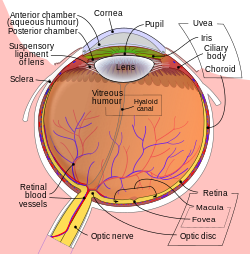Pigment dispersion syndrome

Editor-In-Chief: Prab R Tumpati, MD
Obesity, Sleep & Internal medicine
Founder, WikiMD Wellnesspedia &
W8MD medical weight loss NYC and sleep center NYC
| Pigment dispersion syndrome | |
|---|---|

| |
| Synonyms | Pigmentary dispersion syndrome |
| Pronounce | N/A |
| Specialty | N/A |
| Symptoms | Blurry vision, halos around lights, eye pain |
| Complications | Pigmentary glaucoma |
| Onset | Typically in young adulthood |
| Duration | Chronic |
| Types | N/A |
| Causes | Unknown, possibly genetic factors |
| Risks | Myopia, male gender, family history |
| Diagnosis | Slit lamp examination, gonioscopy, intraocular pressure measurement |
| Differential diagnosis | Glaucoma, uveitis, keratitis |
| Prevention | N/A |
| Treatment | Medications, laser therapy, surgery |
| Medication | N/A |
| Prognosis | N/A |
| Frequency | Rare |
| Deaths | N/A |
Pigment Dispersion Syndrome is a medical condition that affects the eye, specifically the iris and the trabecular meshwork. It is characterized by the dispersion of pigment granules into the anterior chamber of the eye. This dispersion can lead to a variety of ocular complications, including glaucoma.
Causes[edit]
The exact cause of Pigment Dispersion Syndrome is not fully understood. However, it is believed to be related to the physical rubbing between the posterior surface of the iris and the zonular fibers of the lens. This friction leads to the dispersion of pigment granules into the anterior chamber of the eye.
Symptoms[edit]
The most common symptom of Pigment Dispersion Syndrome is the presence of pigment granules in the anterior chamber of the eye. Other symptoms may include blurred vision, halos around lights, and ocular pain. In some cases, the condition may lead to the development of glaucoma, which can cause additional symptoms such as loss of peripheral vision and increased intraocular pressure.
Diagnosis[edit]
Diagnosis of Pigment Dispersion Syndrome is typically made through a comprehensive eye examination. This may include a visual acuity test, a dilated eye exam, and an examination of the anterior chamber of the eye using a slit lamp. In some cases, additional tests such as gonioscopy or optical coherence tomography may be used to confirm the diagnosis.
Treatment[edit]
Treatment for Pigment Dispersion Syndrome is primarily aimed at managing the symptoms and preventing the development of glaucoma. This may include the use of eye drops to reduce intraocular pressure, laser therapy to improve the drainage of aqueous humor, or in severe cases, surgery.
See Also[edit]
References[edit]
<references />
Ad. Transform your life with W8MD's Budget GLP-1 injections from $75


W8MD offers a medical weight loss program to lose weight in Philadelphia. Our physician-supervised medical weight loss provides:
- Weight loss injections in NYC (generic and brand names):
- Zepbound / Mounjaro, Wegovy / Ozempic, Saxenda
- Most insurances accepted or discounted self-pay rates. We will obtain insurance prior authorizations if needed.
- Generic GLP1 weight loss injections from $75 for the starting dose.
- Also offer prescription weight loss medications including Phentermine, Qsymia, Diethylpropion, Contrave etc.
NYC weight loss doctor appointmentsNYC weight loss doctor appointments
Start your NYC weight loss journey today at our NYC medical weight loss and Philadelphia medical weight loss clinics.
- Call 718-946-5500 to lose weight in NYC or for medical weight loss in Philadelphia 215-676-2334.
- Tags:NYC medical weight loss, Philadelphia lose weight Zepbound NYC, Budget GLP1 weight loss injections, Wegovy Philadelphia, Wegovy NYC, Philadelphia medical weight loss, Brookly weight loss and Wegovy NYC
|
WikiMD's Wellness Encyclopedia |
| Let Food Be Thy Medicine Medicine Thy Food - Hippocrates |
Medical Disclaimer: WikiMD is not a substitute for professional medical advice. The information on WikiMD is provided as an information resource only, may be incorrect, outdated or misleading, and is not to be used or relied on for any diagnostic or treatment purposes. Please consult your health care provider before making any healthcare decisions or for guidance about a specific medical condition. WikiMD expressly disclaims responsibility, and shall have no liability, for any damages, loss, injury, or liability whatsoever suffered as a result of your reliance on the information contained in this site. By visiting this site you agree to the foregoing terms and conditions, which may from time to time be changed or supplemented by WikiMD. If you do not agree to the foregoing terms and conditions, you should not enter or use this site. See full disclaimer.
Credits:Most images are courtesy of Wikimedia commons, and templates, categories Wikipedia, licensed under CC BY SA or similar.
Translate this page: - East Asian
中文,
日本,
한국어,
South Asian
हिन्दी,
தமிழ்,
తెలుగు,
Urdu,
ಕನ್ನಡ,
Southeast Asian
Indonesian,
Vietnamese,
Thai,
မြန်မာဘာသာ,
বাংলা
European
español,
Deutsch,
français,
Greek,
português do Brasil,
polski,
română,
русский,
Nederlands,
norsk,
svenska,
suomi,
Italian
Middle Eastern & African
عربى,
Turkish,
Persian,
Hebrew,
Afrikaans,
isiZulu,
Kiswahili,
Other
Bulgarian,
Hungarian,
Czech,
Swedish,
മലയാളം,
मराठी,
ਪੰਜਾਬੀ,
ગુજરાતી,
Portuguese,
Ukrainian


